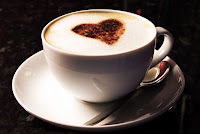 So, you've got one of those clever coffee machines at home. But do your creative efforts miss the mark when compared with your local coffee shop? Are you struggling to make a great cappuccino or latte?
So, you've got one of those clever coffee machines at home. But do your creative efforts miss the mark when compared with your local coffee shop? Are you struggling to make a great cappuccino or latte? You're not alone, making the perfect cup is quite an art. Maybe a few professional tips wouldn't go amiss. But where to go for definitive advice?
I decided to pop down to my local Caffè Nero, a regular haunt in any case, and have a chat to award winning coffee maestro Eniko Marta. The resulting conversation was quite revealing, so I thought I'd share it with you.
First, let's make sure you're fully prepared. You already have your coffee machine and built-in steamer. But what else do you need?
A coffee tamper tool is one item - maybe it's still in the box? A strong, heat-resistant jug, stainless steel being an excellent choice. The jug can have a round edge or pointed lip (it makes a difference, as we'll see later). A thermometer is another key item. Full, semi, skimmed or soya milk, but it has to be fresh. Your favourite blend of ground coffee. And a pre-warmed coffee cup.
In reality there's not much to go wrong with the expresso part of the coffee making process. Loading the machine is straightforward enough, but tamping the coffee into the filter holder will make a difference. Tamping slows the flow of water through the coffee, increasing the shot strength. Some machines also have an adjustable water flow setting.
For best results the milk should be added as soon as the expresso is ready. This way you'll capture the rich crema (a creamy foam) floating on the top of the coffee. Wait too long and the crema will dissipate, so timing is important.
To create a perfect cup of white coffee, you'll have to pay close attention to milk preparation. There are a number of little tips to pass on. Firstly, the temperature has to be right. Too cold and you'll have a lukewarm beverage, too hot and as Eniko says, "You'll burn the milk!", giving your coffee an unpleasant after taste.
Let's get started. After putting the required quantity of milk into your sturdy jug, place the steamer nozzle deep into the centre. This is where the thermometer comes in.
Taking cow's milk first, the target to aim for is 60C (140F). Watch the thermometer carefully, and turn off the steamer as soon as it hits this temperature. "Notice," she says, "after turning the steamer off, the temperature rises a little more." And it does, by around 10C. For an extra hot cup you can leave the steamer on until it rises to 72C (160F). Any higher and it's likely to burn.
Soya milk is a little more sensitive to heat than cow's milk, so here you should be aiming at 50C (120F). "Is soya milk harder to work with?" I ask. "No," she answers, "with soya it's actually easier to get the right consistency." which is an interesting observation.
Talking of consistency, what exactly are you looking for? Well, as you'd expect all this aeration produces thousands of bubbles in the milk. However, what isn't obvious is you're aiming to create small, even-size bubbles.
After steaming, raise the nozzle gently and wait around 20 seconds for the milk to settle. Now for a key trick. Sharply tap the jug of steamed milk onto the worktop a few times (hence the need for a strong jug). This tapping removes the larger bubbles and makes for a smoother, creamier end product. Get it right and you should see a flat surface on your aerated milk.
How do you add the milk to the coffee? Well, it depends on the drink you're trying to make.
For a cappuccino it's poured slowly and carefully into the centre of the cup. "Choose a jug with a simple rounded edge." Eniko advises. For a latte it's still poured carefully into the centre, but initially the froth is held back with a spoon, then released towards the end.
Wondering how to create a flat white? "What you need to do" she suggests, "is pour the milk under the surface of the crema." Holding the cup at and angle and pouring it near the edge will help. And as she revealed, "Using a jug with a pointed-shaped nozzle makes this a lot easier."
So there you have it, a perfect cup of coffee. Well, maybe not the first time - but practice makes perfect, as they say.
If you'd like a book recommendation on the subject of artful coffee, Eniko recommends The Art and Craft of Coffee by Kevin Sinnott.